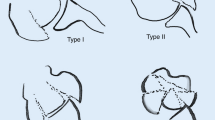Summary
Segmental fractures of the tibial shaft are always caused by a high-energy direct trauma. They are frequently associated with important soft tissue injuries, and the vascularization of the intermediate bone fragment is severely disturbed. The postoperative problems of 40 patients with 41 segmental tibial shaft fractures were reviewed. Twenty-three fractures (56.1%) were treated with a plate osteosynthesis, 18 (43.9%) with an external fixator. Thirty-seven fractures could be followed-up until bony consolidation. Bone-healing problems were seen in 29%, always in the distal fracture. A good functional result, could be obtained in 78.4%. The problems of each stabilization method are discussed. The vascularization of the intermediate segment may not be endangered secondarily by the stabilization procedure.
Zusammenfassung
Die Etagenfraktur des Tibiaschaftes entsteht immer nach einem hochenergetischen und direkten Trauma. Sehr oft sind schwere Begleitverletzungen der Weichteile vorhanden und die Durchblutung des intermediären Knochensegmentes ist schwer gestört. Die postoperativen Probleme von 40 Patienten mit 41 Etagenfrakturen des Tibiaschaftes wurden nachgesehen. 23 Frakturen (56,1%) wurden mit einer Plattenosteosynthese, 18 (43,9%) mit einer äußeren Fixation versorgt. 37 Frakturen konnten bis zur Knochenheilung nachverfolgt werden. Frakturheilungsstörungen wurden in 29% gesehen, immer in der distalen Fraktur. Ein gutes funktionelles Ergebnis konnte in 78,4% erreicht werden. Die spezifischen Probleme jeder Stabilisierungsmethode werden besprochen. Die Durchblutung des intermediären Knochensegmentes darf durch das Osteosyntheseverfahren sicherlich nicht gefährdet werden.
Similar content being viewed by others
References
Degreif J, Ahlers J, Ritter G (1987) Behandlungsergebnisse nach Versorgung von Unterschenkeletagenbrüchen. Unfallchirurgie 13:110–117
Gotzen L, Brudermann U (1984) Monofixateur: optimized unilateral external fixation. Med Focus 3:8–10
Johner R, Wruhs O (1983) Classification of tibial shaft fractures and correlation with results of rigid internal fixation. Clin Orthop 178:7–24
Koechlin P, Briand B, Apoil A (1983) Traitement des fractures bifocales de, jambe. Ann Chir 37:332–336
Langard O, Bo O (1976) Segmental tibial shaft fractures. Acta Orthop Scand 47:351–357
Melis GC, Sotgiu F, Lepori M, Guido P (1981) Intramedullary nailing in segmental tibial fractures. J Bone Joint Surg [Am] 63:1310–1318
Mommsen U, Stammer HJ, Jungbluth KH (1980) Der Unterschenkeletagenbruch. Unfallchirurgie 6:178–182
Rhinelander FW (1974) Tibial blood supply in relation to fracture healing. Clin Orthop 105:34–40
Rommens P, Broos P, Gruwez JA (1986) Nachuntersuchungsergebnisse von 102 mit DC-Plattenosteosynthese-stabilisierten Tibiaschaftfrakturen. Unfallchirurgie 12: 320–326
Tscherne H, Oestern HJ (1982) Die Klassifizierung des Weichteilschadens bei offenen und geschlossenen Frakturen. Unfallheilkunde 85:11–16
Author information
Authors and Affiliations
Rights and permissions
About this article
Cite this article
Rommens, P.M., Coosemans, W. & Broos, P.L.O. The difficult healing of segmental fractures of the tibial shaft. Arch Orthop Trauma Surg 108, 238–242 (1989). https://doi.org/10.1007/BF00936208
Issue Date:
DOI: https://doi.org/10.1007/BF00936208




